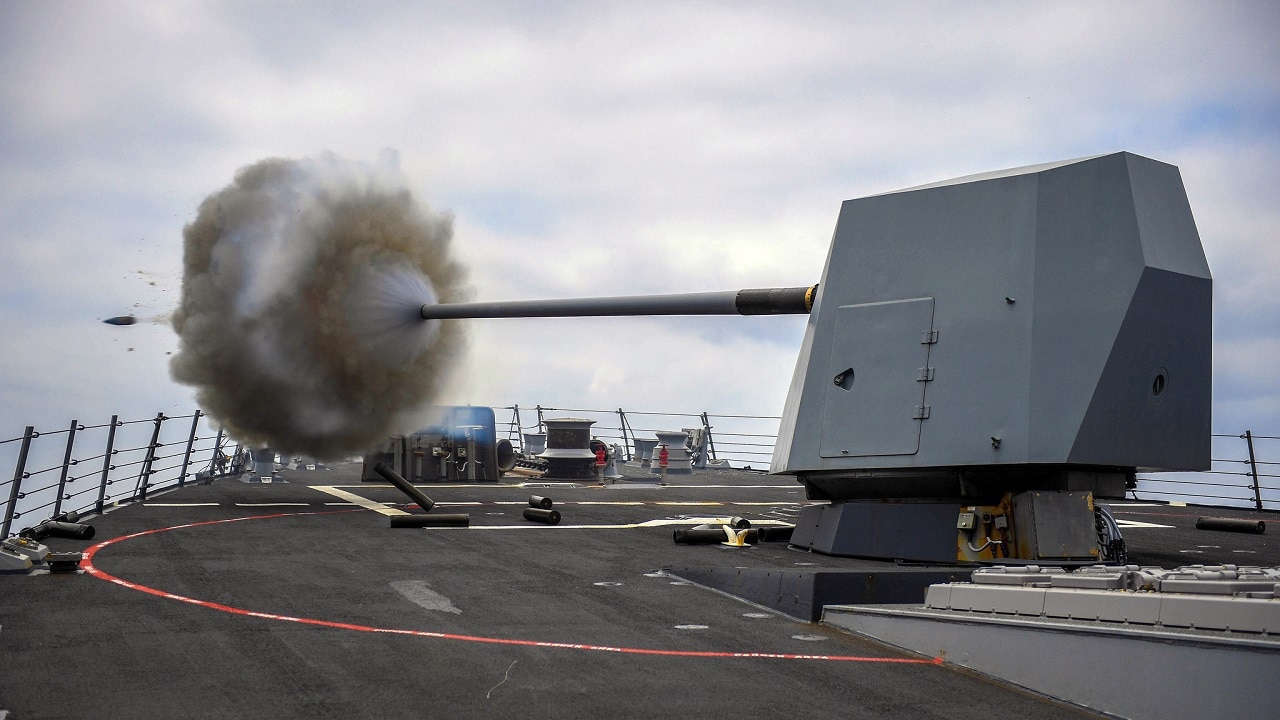Key Points: NATO warships operating in the Red Sea are increasingly employing deck guns—ranging from 5-inch cannons seen below to smaller autocannons—to shoot down attacking Houthi drones.
-This tactical shift addresses the high cost and limited availability of using sophisticated surface-to-air missiles against numerous, inexpensive drones.
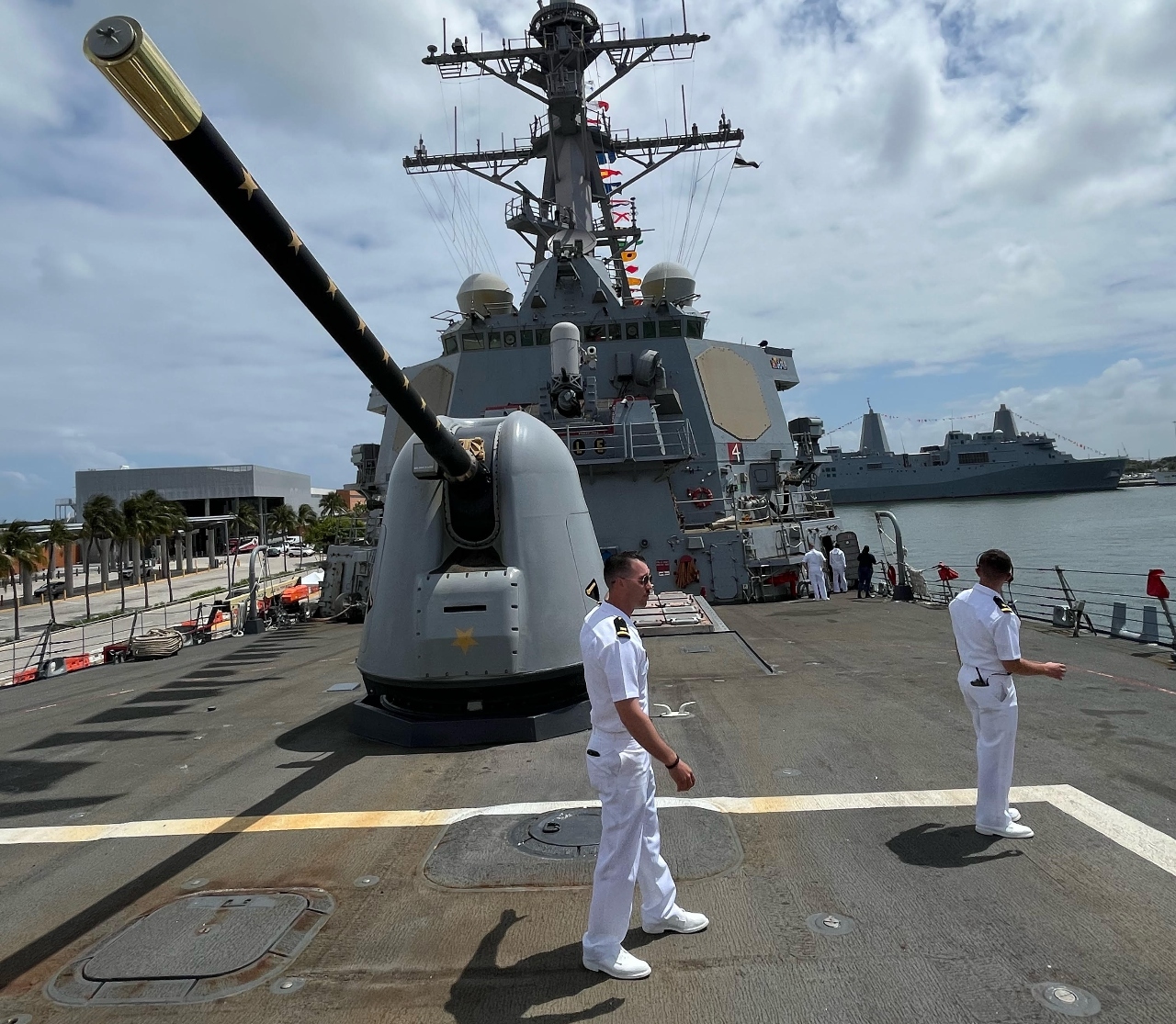
5-Inch Gun from U.S. Navy Warship. Image Credit: Reuben F. Johnson.
-Recent incidents, including successful engagements by a French frigate and the USS Stockdale, demonstrate the viability of this approach.
-While guns offer shorter engagement ranges, their large ammunition capacity provides a crucial, cost-effective layer of defense against the persistent drone threat faced in modern maritime conflicts like the Red Sea.
Guns Blazing: NATO Warships Now Using Cannons to Fight Off Houthi Drones
The United States, along with other NATO allies, is involved in an escalating shooting war in the Red Sea that pits its warships against the Yemen-based Houthi rebels.
The Houthis are using a variety of weapons to harass the NATO vessels, including anti-ship missiles and drones of varying size and type.
Avoiding these munitions sometimes requires a warship to conduct swift and rapid maneuvers at sea—and such moves can have unpleasant consequences of their own. Last week, the aircraft carrier USS Harry S. Truman maneuvered to avoid incoming fire. Its hard turn pushed the deck to pitch up at a steep angle and caused an F/A-18E Super Hornet to roll overboard off of the flight deck. A crew member was injured in the event.
The standard weapon used to take out an enemy drone is a surface-to-air missile (SAM), but drones are being thrown at these ships in increasing numbers, making SAMs an impractical solution.
For one, ships can carry only a limited number of such missiles. Destroyers in U.S. Carrier Strike Groups generally are equipped with as many as 96 vertical-launch-system cells. Moreover, not all the launch tubes carry U.S. Navy Standard Missile interceptors—the SM-2, SM-3, or SM-6. Some of them are loaded with land-attack missiles instead.
The other complication is cost. SAMs are expensive pieces of weaponry, with even the cheapest designs costing more than $1 million. Considering the average drone might cost a couple thousand dollars, firing a SAM is a poor trade-off.
Don’t Bring a SAM to a Gun Fight
Increasingly, NATO warships are turning to their deck guns to target incoming drones. These include everything from 5-inch deck guns to the Phalanx close-in weapon system —all the way down to the simple M2 Browning heavy machine guns mounted at several deck stations.
The standard Mk-45 5-inch deck gun used on U.S. destroyers and cruisers was first deployed with the fleet in 1971. It is designed to be used against any kind of target, on the surface, in the air, or on land. The weapon is also radar-guided and has a range of up to 13 nautical miles. In fully automatic mode, it has a rate of fire of up to 20 rounds per minute.
Earlier this month, France’s military released footage of one of its frigates assigned to Red Sea patrol duty using its deck gun to destroy an incoming Houthi drone. The weapon employed appears to be an Italian-made 76-mm naval autocannon, the like of which has been in service with the Marine Nationale since the 1960s. It fired several rounds in the direction of what the crew believed to be an enemy drone, with the target then exploding in mid-air.
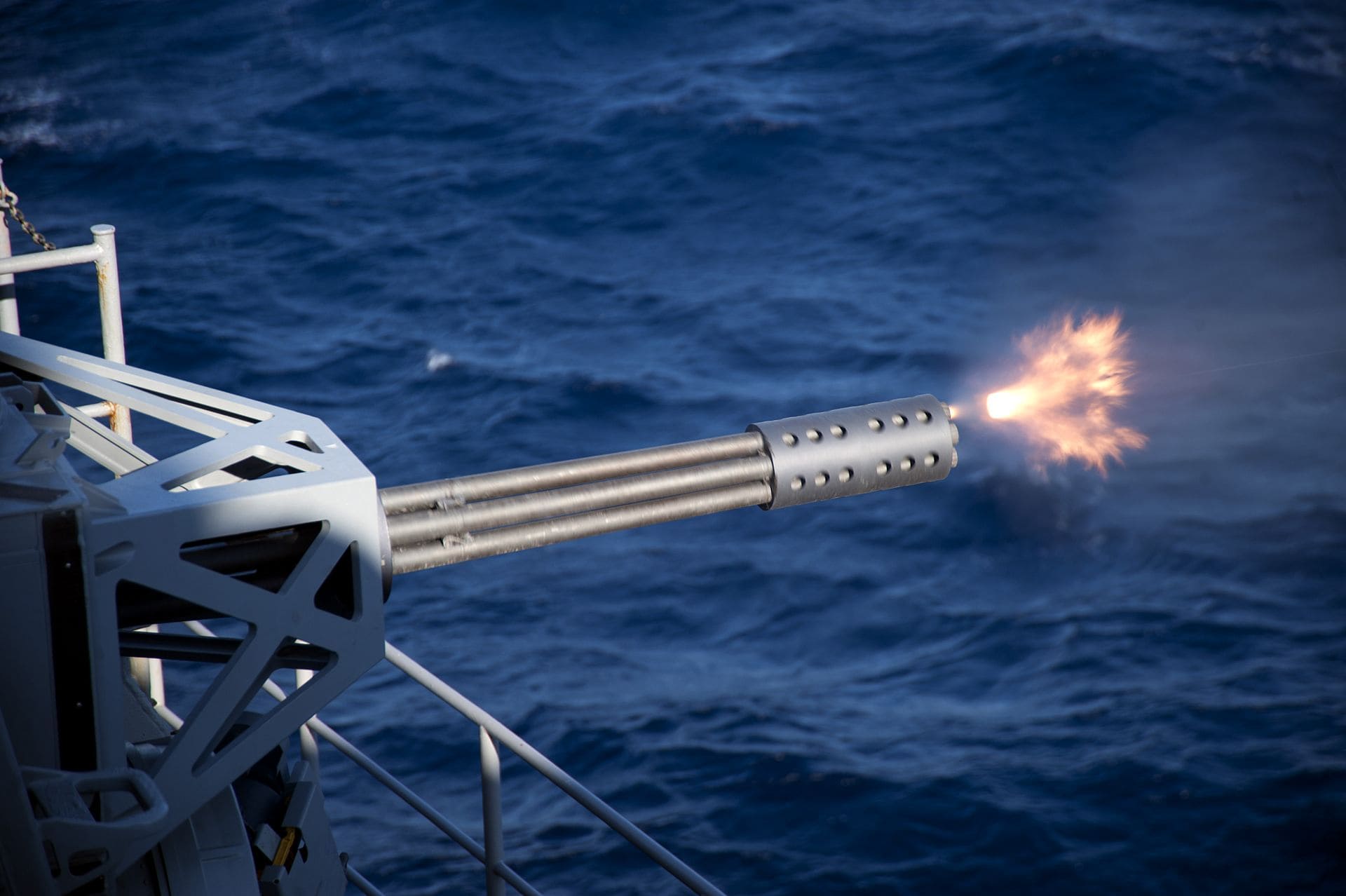
Phalanx Gun. Image Credit: Creative Commons.
The French crew was apparently so surprised at the appearance of the drone that they fired the autocannon without removing the weapon’s rubber gun plug. (According to the French military, the plug is of a type that permits “emergency firing” while still on the end of the gun’s barrel.)
This incident was only the latest of several in which a NATO warship used one of its deck guns to destroy a Houthi drone, demonstrating that these weapons are of increasing utility in this new kind of maritime warfare.
Do You Feel Lucky?
The drawback of using a naval gun in this scenario is that its range stops at about 10 miles. That makes the gun its ship’s last line of defense. Failure to take out the threat could leave the vessel open to serious battle damage.
In November 2024, the U.S. Navy destroyer USS Stockdale was engaged in what has been described as an “hours-long shoot-out with the Houthis.” A low-flying drone managed to get close to the ship undetected and crossed to its front. The drone was target-locked and destroyed by the ship’s 5-inch main gun.
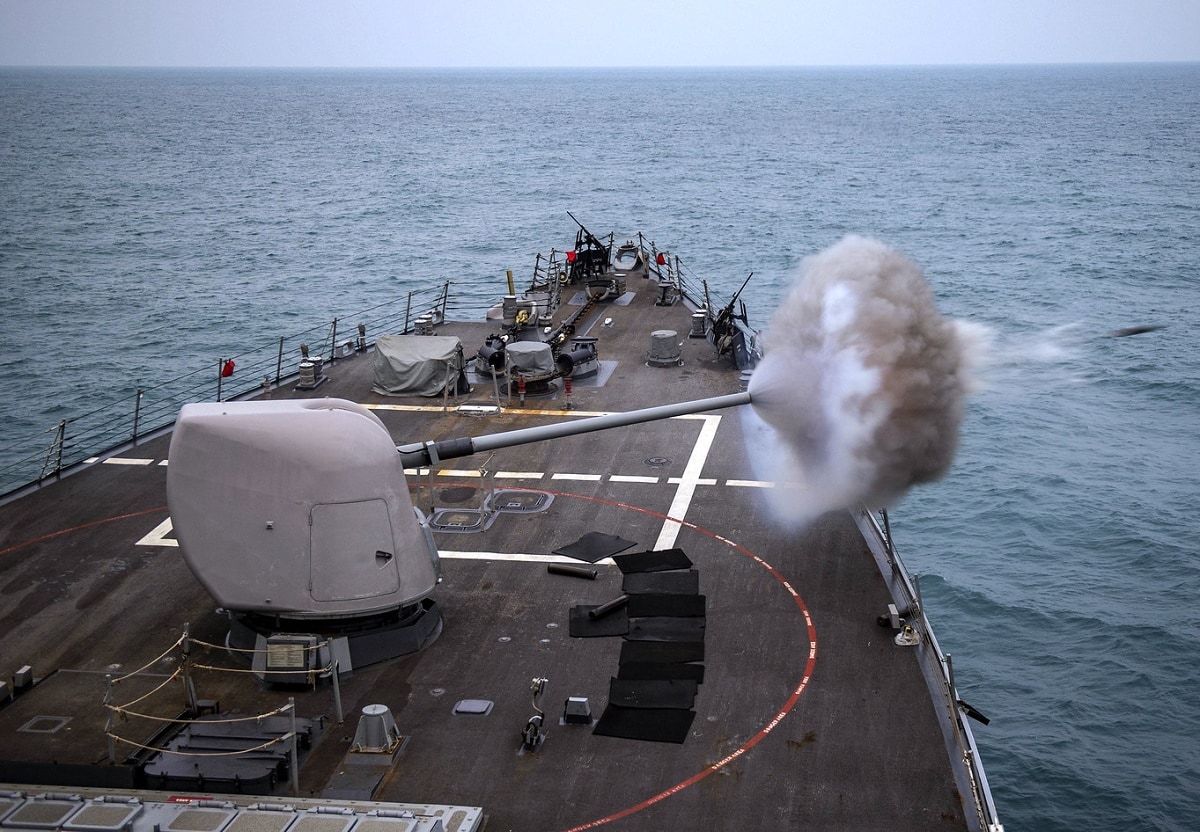
ARABIAN GULF (Dec. 18, 2020) The guided-missile destroyer USS John Paul Jones (DDG 53) fires its Mark 45 5-inch gun during a live-fire exercise in the Arabian Gulf, Dec. 18, 2020. John Paul Jones is part of the Nimitz Carrier Strike Group and is deployed to the U.S. 5th Fleet area of operations in support of naval operations to ensure maritime stability and security in the Central Region, connecting the Mediterranean and the Pacific through the western Indian Ocean and three strategic choke points critical to the free flow of global commerce. (U.S. Navy photo by Mass Communication Specialist 3rd Class Aja Bleu Jackson) 201218-N-XG173-1132
Arleigh Burke-class destroyers carry 600 rounds of conventional ammunition for the single Mk-45 main 5-inch gun, while Ticonderoga-class cruisers, which have two of the Mk-45s mounted topside, carry up to 1,200 shells. These are several orders of magnitude greater numbers than the maximum number of SAMs normally carried on board.
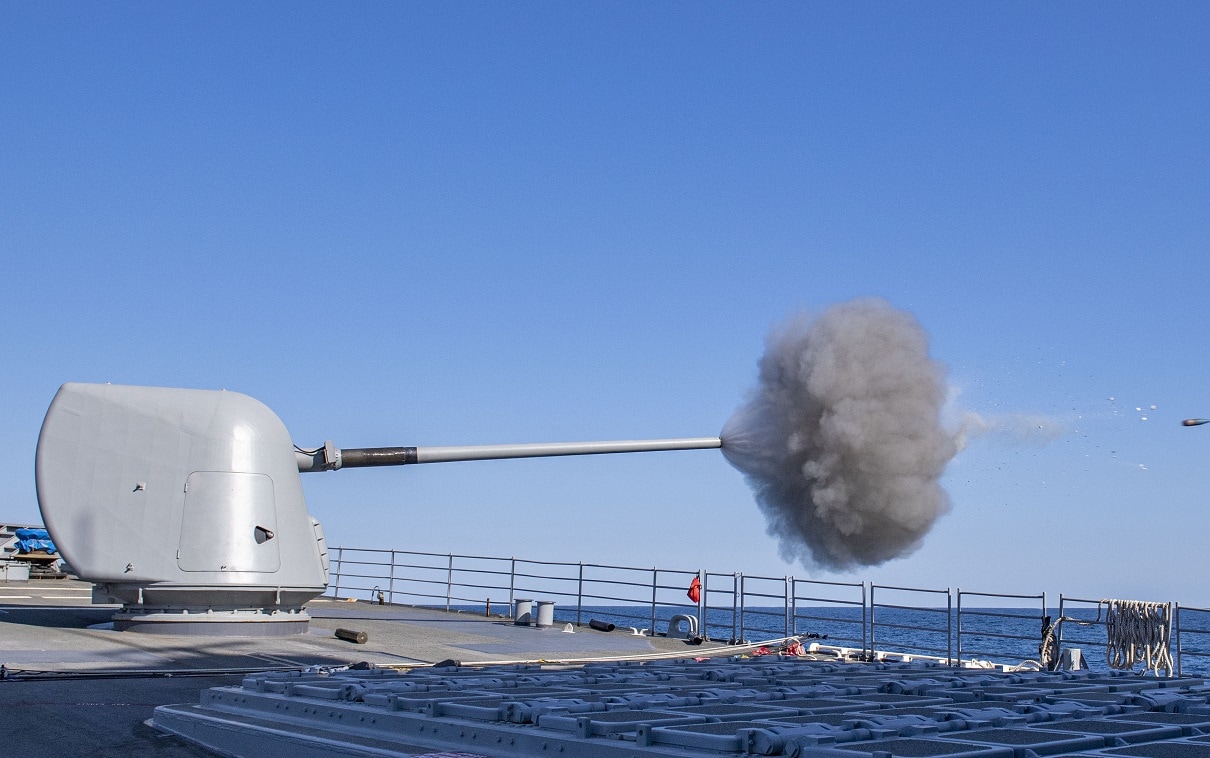
ARABIAN SEA (Jan. 14, 2020) The guided-missile cruiser USS Normandy (CG 60) fires its forward Mark 45 mod 4 5-inch gun during a live-fire exercise. The Normandy is part of the Harry S. Truman Carrier Strike Group and is deployed to the U.S. 5th Fleet area of operations in support of naval operations to ensure maritime stability and security in the Central Region, connecting the Mediterranean Sea and Pacific Ocean through the western Indian Ocean and three strategic choke points. (U.S. Navy photo by Mass Communication Specialist 2nd Class Michael H. Lehman/Released)200114-N-PC620-0132
Hitting one of these drones with the deck gun requires more surveillance of the surrounding airspace, a well-trained gun crew, and good visibility, which requires luck. What is likely to happen in the near future are enhancements to the ships’ on-board radars, and improvements in linking radar tracks to the gun’s fire control system so as to increase its effectiveness against drones.
About the Author
Reuben F. Johnson is a survivor of the February 2022 Russian invasion of Ukraine and is an Expert on Foreign Military Affairs with the Fundacja im. Kazimierza Pułaskiego in Warsaw. He has been a consultant to the Pentagon, several NATO governments and the Australian government in the fields of defense technology and weapon systems design. Over the past 30 years he has resided in and reported from Russia, Ukraine, Poland, Brazil, the People’s Republic of China and Australia.

